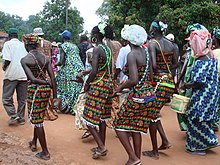Ajamat | |
|---|---|
 Jola girls dancing | |
| Total population | |
| 900,000[1] | |
| Regions with significant populations | |
| Senegal, the Gambia, Guinea-Bissau | |
| 687,852 (4%)[2] | |
| 182,807 (10.5%)[3] | |
| 6,000 (0.4%)[4] | |
| Languages | |
| Jola, French, Kriol, English, Portuguese | |
| Religion | |
| Majority: Islam[5] Significant minority: African traditional religion (Jola religion), Christianity[5] | |
| Related ethnic groups | |
| Serer people and Wolof people | |
The Jola or Diola (endonym: Ajamat) are an ethnic group found in Senegal, the Gambia, and Guinea-Bissau. Most Jola live in small villages scattered throughout Senegal, especially in the Lower Casamance region.[6] The main dialect of the Jola language, Fogni, is one of the six national languages of Senegal.[7]
Their economy has been based on wet rice cultivation for at least one thousand years.[8] This system has been characterised "one of the most significant examples of 'agrarian civilizations' in West Africa".[9] However, the Jola probably reached the Lower Casamance region in the 14th century, assimilating the previous Bainuk people and their rice tradition.[10][11] In colonial times, the Jola began to cultivate peanuts as a cash crop in the drier forests.[6] Other activities include palm wine tapping, honey collecting, livestock rearing and the production of other crops such as sweet potatoes, yams and watermelon.[12]
The traditional religion of the Jola is animism, which is practised through fetishistic rituals and ceremonies. However, the Jola populations living in well-connected areas have become Islamized due to the influence of the nearby Mandinka people. As a result, many Jola no longer speak their own language and more than half are now Muslims.[6] Unlike the dominant cultures of West Africa, most Jola communities lack any social or political stratification, being organised into families or neighbourhoods. However, some communities have a central authority, a king, whose role resembles more that of a priest than of a traditional secular leader.[10] The most prominent Jola kingdom is in Oussouye.[10] Among the Muslim Jola, there is also the marabout, a religious leader and teacher. Traditional animist rituals are overseen by elders, who have an important role in Jola society. For Jola boys to attain manhood, they must take part in the initiation festival known as futamp, which takes place every 15 to 20 years in every Jola village.
- ^ Klein, Martin A. "Shrines of the Slave Trade: Diola Religion and Society in Precolonial Senegambia." The Journal of Interdisciplinary History 31.2 (Autumn 2000): 315. Accessed through Gale (Cengage), 6 Aug. 2009
- ^ "Senegal Population 2021 (Demographics, Maps, Graphs)". worldpopulationreview.com. Retrieved 2021-06-17.
- ^ "Distribution of the Gambian population by ethnicity 1973,1983,1993,2003 and 2013 Censuses – GBoS". www.gbosdata.org. Archived from the original on 2021-11-19. Retrieved 2021-06-17.
- ^ "Guinea-Bissau | World Directory of Minorities & Indigenous Peoples". Minority Rights Group. Retrieved 2021-06-18.
- ^ a b "Understanding the Personalistic Aspects of Jola Ethnomedicine". Retrieved 2021-06-17.
- ^ a b c Olson, James Stuart; Meur, Charles (1996). The Peoples of Africa: An Ethnohistorical Dictionary. Greenwood Publishing Group. pp. 255–256. ISBN 978-0-313-27918-8.
- ^ Minahan, James (2002). Encyclopedia of the Stateless Nations: Ethnic and National Groups Around the World A–Z. ABC-CLIO. p. 397. ISBN 978-0-313-07696-1.
- ^ Davidson, Joanna (2009). ""We Work Hard": Customary Imperatives of the Diola Work Regime in the Context of Environmental and Economic Change". African Studies Review. 52 (2): 119–141. doi:10.1353/arw.0.0179. ISSN 0002-0206. JSTOR 20638911. S2CID 144115501.
- ^ Sané, Tidiane; Mering, Catherine; Cormier-Salem, Marie-Christine; Diédhiou, Ibrahima; Ba, Boubacar Demba; Diaw, Amadou Tahirou; Tine, Alfred Kouly (2018). "Permanences et mutations dans les terroirs rizicoles de Basse-Casamance (Sénégal)" (PDF). Espace Géographique. 47 (3): 201. doi:10.3917/eg.473.0201.
- ^ a b c Peacock, James L.; Thornton, Patricia M.; Inman, Patrick B. (2007). Identity Matters: Ethnic and Sectarian Conflict. Berghahn Books. p. 165. ISBN 978-1-84545-308-4.
- ^ Knörr, Jacqueline; Kohl, Christoph (2016). The Upper Guinea Coast in Global Perspective. Berghahn Books. p. 102. ISBN 978-1-78533-070-4.
- ^ Stride, G. T.; Ifeka, Caroline , Peoples and empires of West Africa: West Africa in history, 1000–1800, Africana Pub. Corp., 1971, p. 6.